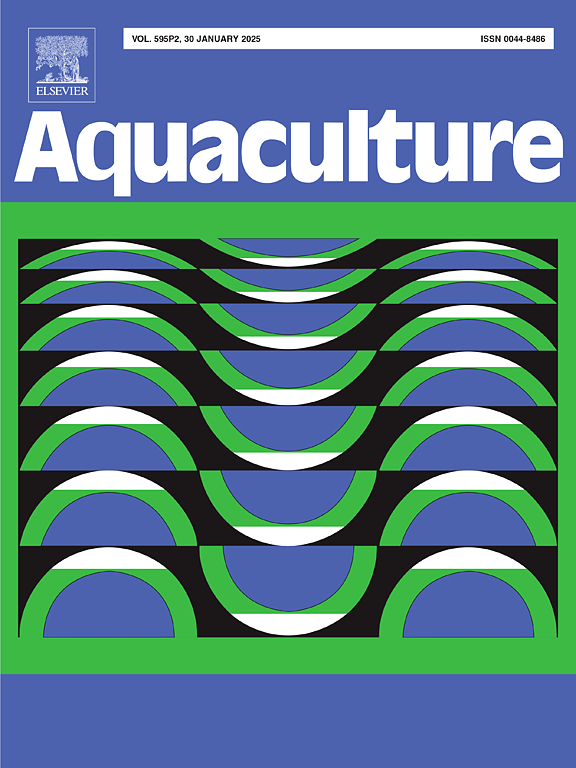注射低剂量疫苗后虹鳟鱼(Oncorhynchus mykiss)的应激和免疫反应
IF 3.9
1区 农林科学
Q1 FISHERIES
引用次数: 0
摘要
动物应激反应由脑皮质-去甲肾上腺素(LC-NE)系统启动,随后激活下丘脑-垂体-肾上腺(HPI)轴。病原体是一种常见的生理应激源,接种疫苗是水产养殖中预防传染病爆发的最常用方法。此外,接种疫苗也是研究感染过程相应生理变化的另一种方法。在本研究中,为了研究自然病原体感染初期神经内分泌和免疫反应之间的相互作用,给虹鳟鱼(Oncorhynchus mykiss)注射了灭活的鳗鲡弧菌细菌素(100 μL)。在不同的时间点对鱼进行采样:分别在感染后 1、6、24 和 72 小时(hpi)采集血液、脑、垂体、头肾、脾、肠和肝脏样本。对血浆中的生化指标(如促肾上腺皮质激素释放激素(CRH)和皮质醇的浓度)进行了分析,并对取样组织中涉及儿茶酚胺合成和代谢、下丘脑-垂体-肾上腺(HPI)轴和免疫反应的基因的 mRNA 水平进行了评估。结果表明,应激参数,包括血浆葡萄糖、蛋白质水平、皮质醇和垂体中 pomcα 的表达在 1 hpi 有显著变化(p < 0.05),而血浆 IL1β 水平和免疫相关基因(包括 il1β、il8、il6)的表达主要在后期(24 hpi、72 hpi)在脾脏和大脑中有显著变化(p < 0.05)。这表明先有应激反应,后有免疫反应。在大脑中也观察到 mao、pnmt 和 dbh 表达的显著变化,这首先意味着儿茶酚胺在局部和系统中的有效作用,其次意味着 LC-NE 系统和 HPI 在维持应激反应中的相互作用。本文章由计算机程序翻译,如有差异,请以英文原文为准。
Stress and immune responses in rainbow trout (Oncorhynchus mykiss) treated by a low dose vaccine injection
The animal stress response is initiated by the locus coeruleus-noradrenaline (LC-NE) system and followed by an activation of hypothalamic-pituitary-interrenal (HPI) axis. Pathogens represent a common physiological stressor, and vaccination is the most used method to prevent bursts of infectious disease in aquaculture. Moreover, vaccination is an alternative way to study the physiological changes corresponding to an infectious process. In the present study, with the aim of investigating the interaction between neuroendocrine and immune responses during the initial stage of natural pathogen infection, rainbow trout (Oncorhynchus mykiss) were injected with inactivated Vibrio anguillarum bacterin (100 μL). Fish were sampled at different time-points: 1, 6, 24, and 72 h post-infection (hpi), and blood, brain, pituitary, head kidney, spleen, intestine, and liver were sampled. Biochemical parameters were analyzed in plasma (e.g., concentrations of corticotropin-releasing hormone (CRH) and cortisol), and the mRNA levels of genes involved in catecholamine synthesis and metabolism, hypothalamic-pituitary-interrenal (HPI) axis, and immune responses were assessed in the sampled tissues. Results showed that stress parameters, including plasma glucose, protein level, cortisol, and expression of pomcα in the pituitary were significantly changed at 1hpi (p < 0.05), while plasma IL1β levels and expression of immune related genes, including il1β, il8, il6, were mainly significantly changed at the latter stages (24 hpi, 72 hpi) in the spleen and brain (p < 0.05). This indicates a first stress response with a latter immune response. Significant changes in the expression of mao, pnmt and dbh in the brain were also observed, implying firstly the effective local and systemic role of catecholamines and secondly interactivities between the LC-NE system and HPI in the maintenance of stress response.
求助全文
通过发布文献求助,成功后即可免费获取论文全文。
去求助
来源期刊

Aquaculture
农林科学-海洋与淡水生物学
CiteScore
8.60
自引率
17.80%
发文量
1246
审稿时长
56 days
期刊介绍:
Aquaculture is an international journal for the exploration, improvement and management of all freshwater and marine food resources. It publishes novel and innovative research of world-wide interest on farming of aquatic organisms, which includes finfish, mollusks, crustaceans and aquatic plants for human consumption. Research on ornamentals is not a focus of the Journal. Aquaculture only publishes papers with a clear relevance to improving aquaculture practices or a potential application.
 求助内容:
求助内容: 应助结果提醒方式:
应助结果提醒方式:


